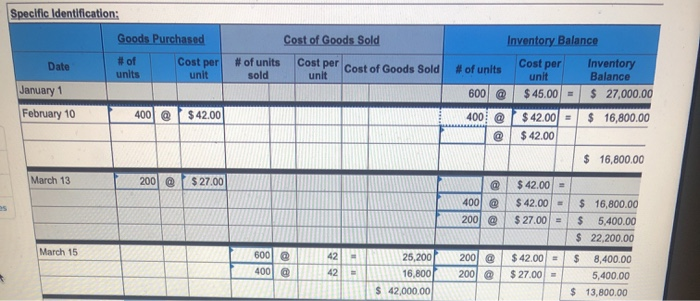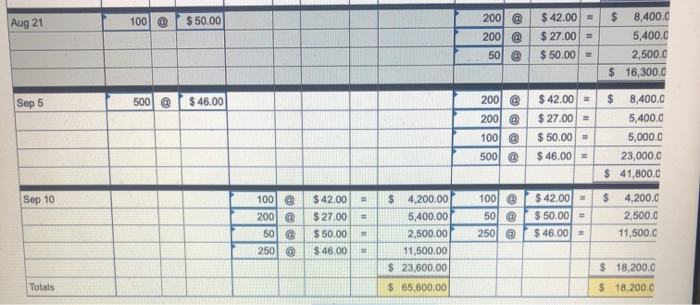Answered step by step
Verified Expert Solution
Question
1 Approved Answer
the final answers should come out to 59,000 for total cost of goods sold and 18,200 for ending inventory however i am having trouble figuring





the final answers should come out to 59,000 for total cost of goods sold and 18,200 for ending inventory however i am having trouble figuring out how to get the numbers to equal that.
Problem 5-3A Perpetual: Alternative cost flows LO P1 Montoure Company uses a perpetual inventory system. It entered into the following calendar-year purchases and sales transactions. Date Activities Units Acquired at Cost Units Sold at Retail Jan. 1 Beginning inventory 600 units @ $45 per unit Feb. 10 Purchase 400 units @ $42 per unit Mar. 13 Purchase 200 units @ R7 per unit Mar. 15 Sales 800 units @ $75 per unit Aug. 21 Purchase 100 units @ $50 per unit Sept. 5 Purchase 500 units @ $46 per unit Sept. 10 Sales 600 units@ $75 per unit Totals 1,800 units 1,400 units Required: 1. Compute cost of goods available for sale and the number of units available for sale. Cost of goods available for sale Number of units available for sale $ 77,200 1,800 units 2. Compute the number of units in ending inventory. Ending inventory 400 units 3. Compute the cost assigned to ending inventory using (a) FIFO, (6) LIFO, (c) weighted average, and (d) specific identification. For specific identification, units sold consist of 600 units from beginning inventory, 300 from the February 10 purchase, 200 from the March 13 purchase, 50 from the August 21 purchase, and 250 from the September 5 purchase. Complete this question by entering your answers in the tabs below. Perpetual Fifo Perpetual LIFO Weighted Average Specific Id Compute the cost assigned to ending inventory using specific identification. For specific identification, units sold consist of from the February 10 purchase, 200 from the March 13 purchase, 50 from the August 21 purchase, and 250 from the Sep cost per unit to 2 decimal places.) Specific Identification: Goods Purchased Cost of Goods Sold Cost per Date # of units # of units sold Cost per Cost of Goods Sold unit unit January 1 February 10 Inventory Balance Cost per Inventory # of units unit Balance 600 @ $ 45.00 - $ 27,000.00 400 $ 42.00= $ 16,800.00 $ 42.00 $ 16,800.00 400 @ $42.00 March 13 2001 $ 27.00 @ 4001 200 @ $ 42.00 = $ 42.00 = $ 16,800.00 $ 27.00 = $ 5,400.00 $ 22,200.00 $ 42.00 $ 8,400.00 $ 27.00 5,400.00 $ 13,800.00 March 15 42 600 400 @ 25,200 16,800 $ 42,000.00 200 @ 200 42 Aug 21 100 $50.00 2001 @ 200 @ 50@ $ 42.00 = $ 27.00 = $ 50.00 = $ 8,400.0 5,400.0 2,500.0 $ 16,300.0 Sep 5 500 @ $ 46.00 $ 2001 @ $ 42.00 = 2001 @ $ 27.00 - 100 @ $50.00 - 500 @ $ 46.00 - 8,400.0 5,400.0 5,000.0 23,000.0 $ 41,800.0 Sep 10 $ $ 1001 @ 200 @ 50 @ 250 @ $ 42.00 $ 27.00 $ 50.00 $ 46.00 4,200.00 5,400.00 2,500.00 11,500.00 $ 23,600.00 100 @ 50 @ 250 @ $ 42.00 $ 50.00 = $ 46.00 4,200.0 2,500.0 11,500.C $ 18,200.0 Totals $ 65,600.00 $ 18,200.0 Step by Step Solution
There are 3 Steps involved in it
Step: 1

Get Instant Access to Expert-Tailored Solutions
See step-by-step solutions with expert insights and AI powered tools for academic success
Step: 2

Step: 3

Ace Your Homework with AI
Get the answers you need in no time with our AI-driven, step-by-step assistance
Get Started


